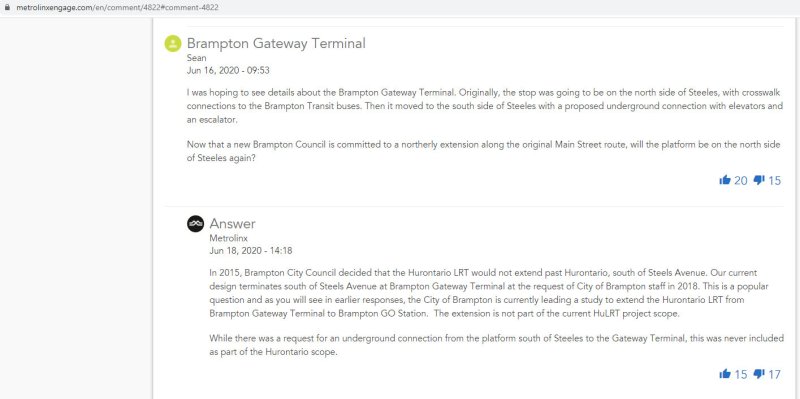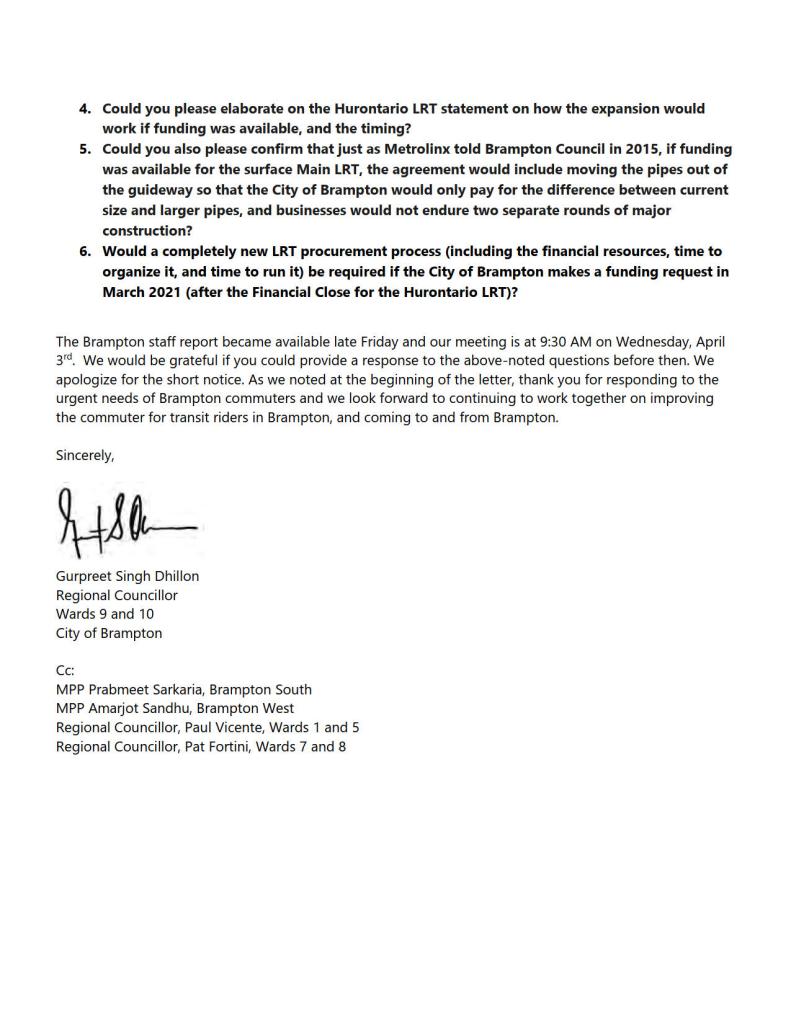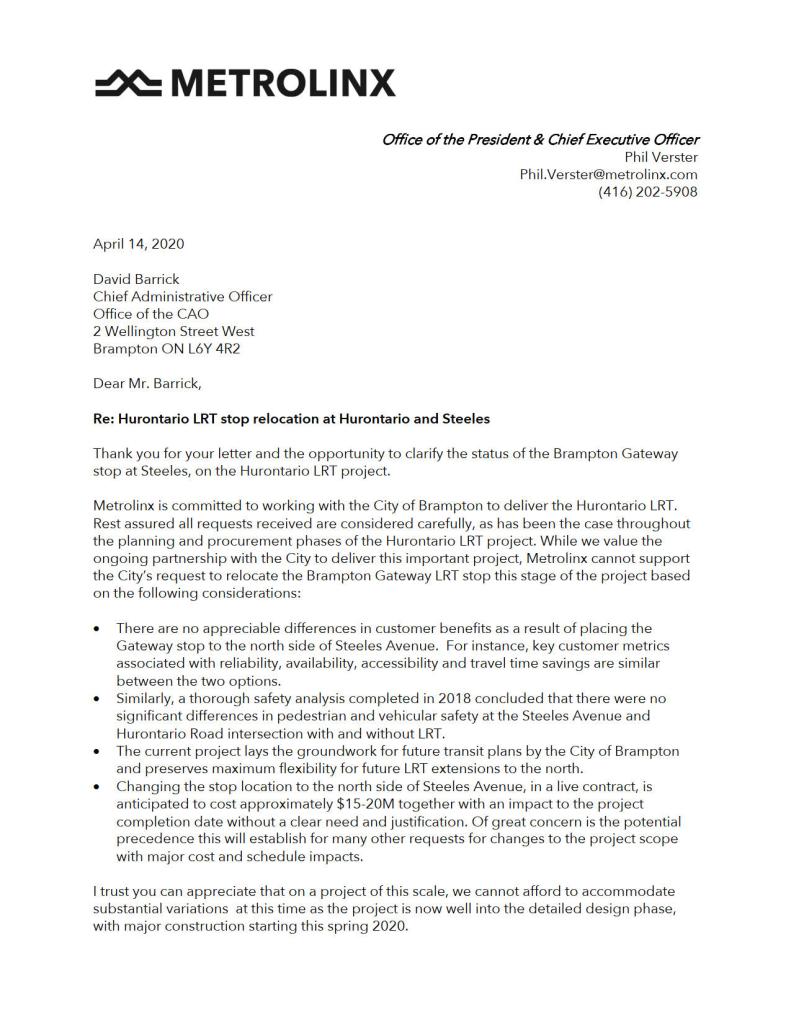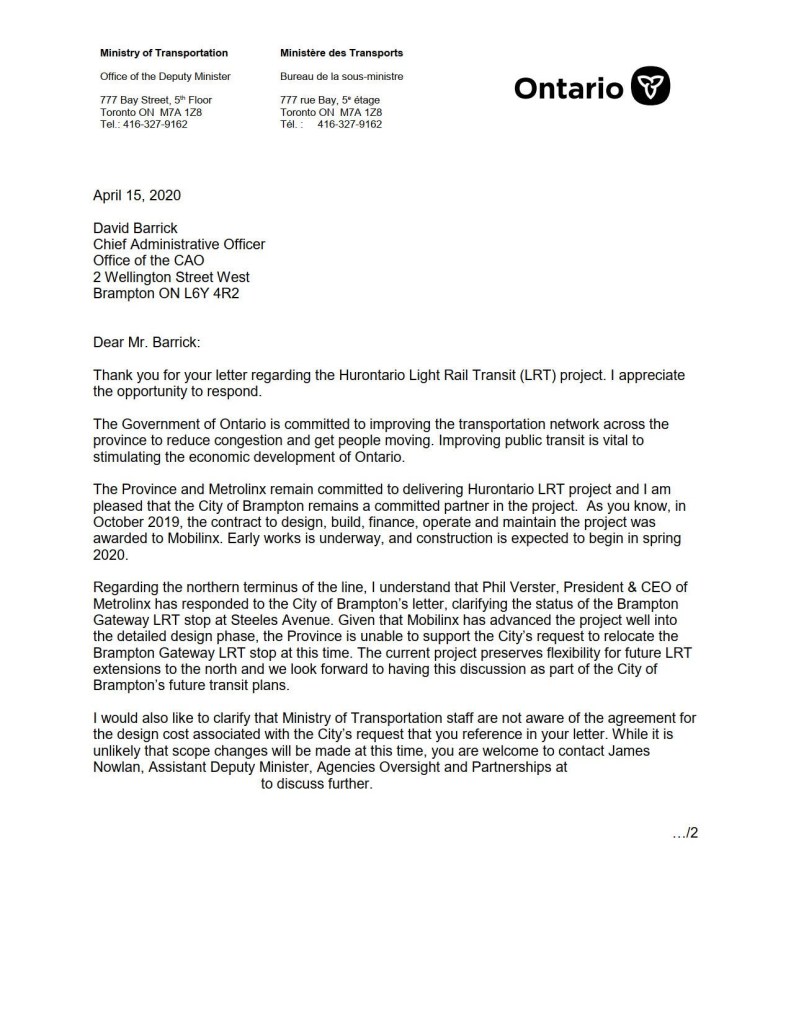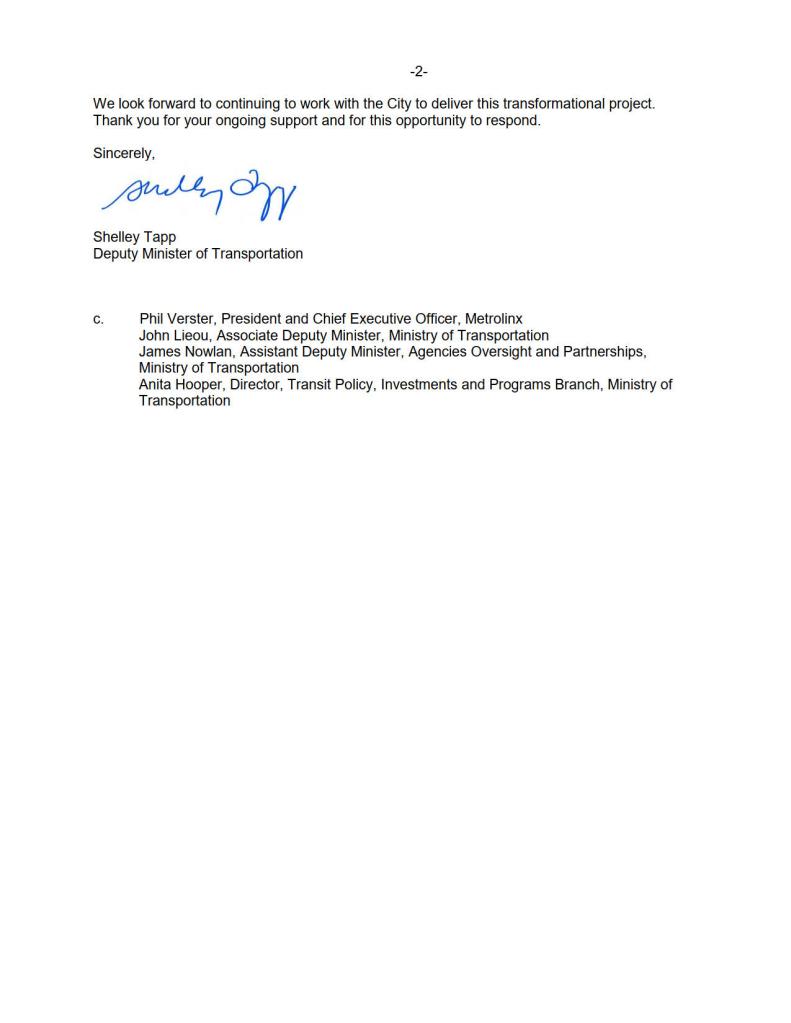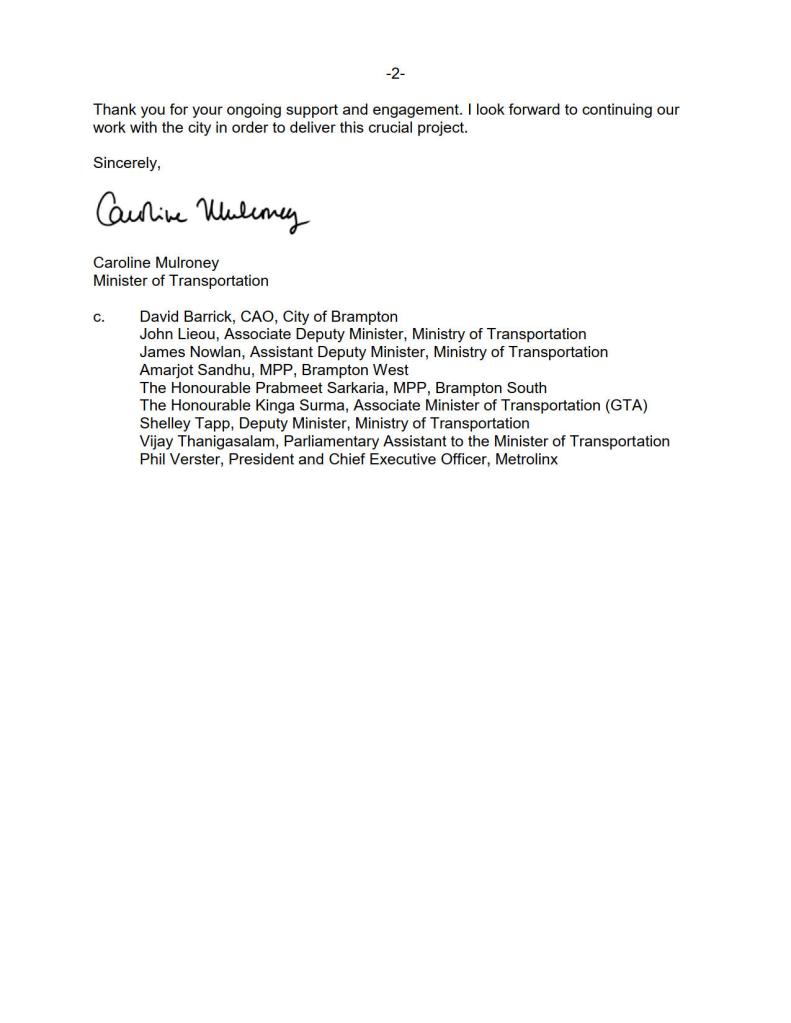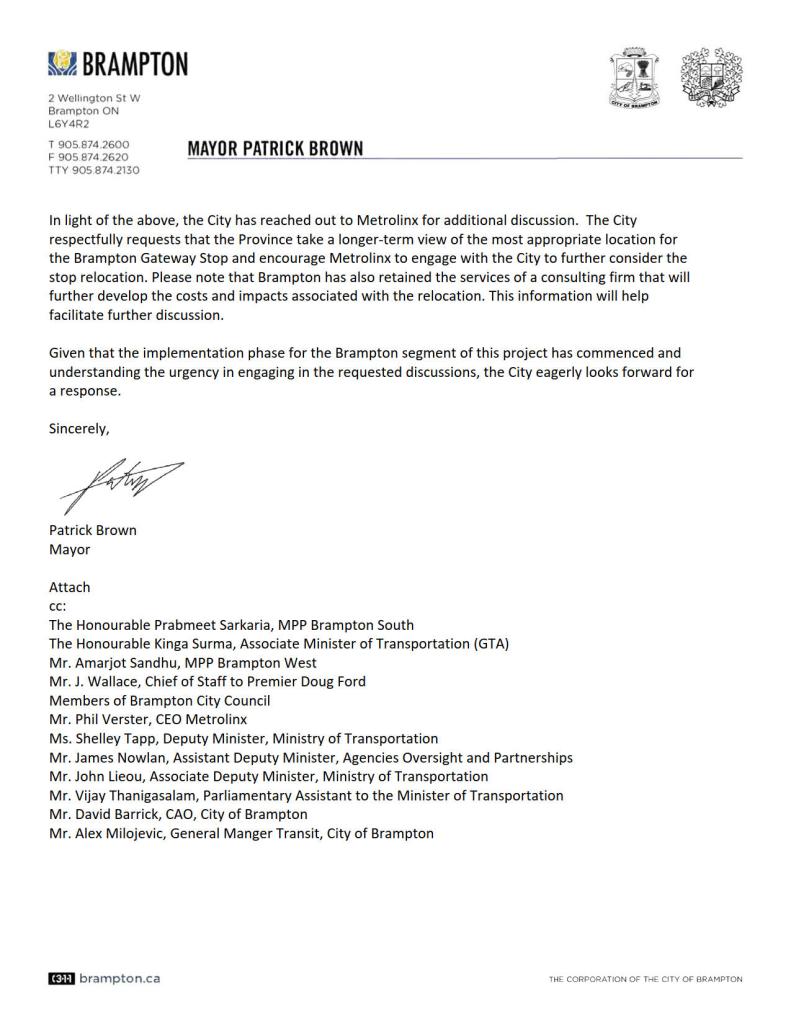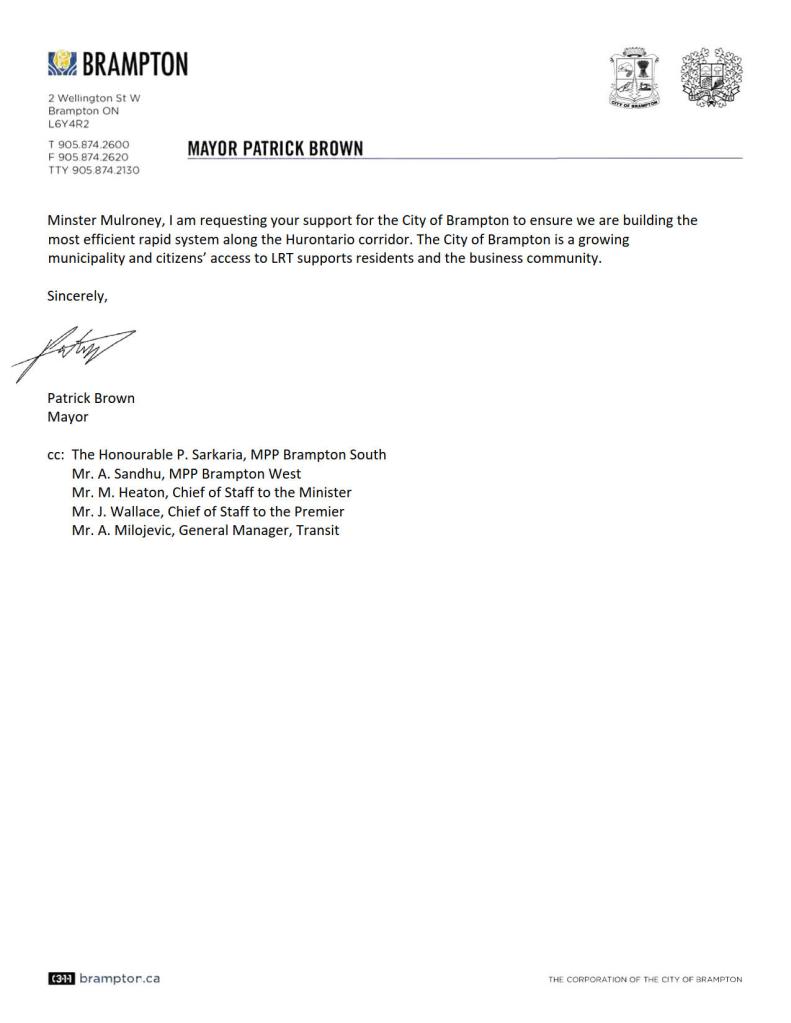
Last year, I wrote about a foreseeable problem coming to the corner of Steeles Avenue and Hurontario and Main Streets in Brampton: the planned Hurontario LRT terminus, to be located on the south side of Steeles Avenue, would require thousands of commuters to transfer to Brampton Transit buses on the north-west corner of the intersection.
This transfer would require crossing ten or eleven lanes of traffic at one of Peel Region’s busiest intersections, with crowding at the street corners, with passengers awaiting a walk signal two separate times to make the necessary connection.
After twice receiving unsatisfactory answers at a Metrolinx online town hall, and hearing no information about how the crossing at this intersection might be mitigated, on March 9, 2021, I took the step of making an Access to Information Request to Metrolinx under the province’s Freedom of Information and Protection of Privacy Act asking for communications between Metrolinx, the Ministry of Transportation, Mobilinx (the consortium awarded the contract to build and operate the LRT), and the City of Brampton.
I received a package with the requested materials from Metrolinx on July 29, 2021. The request cost me $360.00, plus a $5.00 application fee. Communications from Metrolinx’s privacy officer were professional, friendly, and very helpful.
Through my request that covered the dates December 1, 2018 to March 11, 2021, I obtained several letters from Brampton officials, including City Councillor Gurpreet Singh Dhillon, Director of Transportation Special Projects Chris Duyvestyn, Chief Administrative Officer David Barrick, and Mayor Patrick Brown to Metrolinx and Ministry of Transportation Officials requesting restoration of the north side stop at Steeles Avenue/Brampton Gateway Terminal. I also obtained replies from senior Metrolinx staff, including President and CEO Phil Verster and the Deputy Minister and the Minster of Transportation.
What is the communications reveal is that decisions made during the 2014-2018 term of Brampton Council significantly tied the hands of everyone involved — both at the City of Brampton (which reversed its previous decisions when a new council was elected in October 2018) — and at Metrolinx, which was quickly working towards finalizing the contracts to construct the transit project. Unfortunately, important details, such as the final configuration of the Steeles-Hurontario/Main intersection, remain unknown. Neither Metrolinx nor the Ministry of Transportation, which funds Metrolinx, appear to grasp the problems that will be caused when thousands of commuters have to cross two major streets at an especially busy intersection.
Despite Brampton’s work since December 2018 to move the Brampton Gateway stop back north of Steeles Avenue, including formal requests to Metrolinx and the Ontario Ministry of Transportation (MTO), and despite a similar request from RioCan, owner of the massive Shoppers World Mall property at Main Street and Steeles Avenue, Metrolinx and the province have held firm in their decision.
Though Metrolinx’s mandate is to “improve the coordination and integration of all modes of transportation in the Greater Toronto and Hamilton Area,” terminating the LRT on the south side of Steeles Avenue will only reduce the integration of transit modes at Brampton Gateway.
While Metrolinx and the MTO cite the difficulties of reopening a project which was getting underway, and concerned about setting precedents for other changes to the Hurontario LRT or other transit projects, this would still be a minor change, costing just $15 to $20 million according to a 2020 letter from Metrolinx CEO and President Phil Verster to Brampton Mayor Patrick Brown.
Sadly, transit riders in Brampton – who do not have affluence or political might — have been left in the middle of this political back-and-forth between municipal politicians, the province, and Metrolinx. They will be forced to endure a more difficult transfer between LRT and bus than anything proposed to them in public consultations.
Background
The planning and politics that led to the Brampton Gateway Terminal location issue date back to 2007. The events that took place between 2014 and 2020 are crucial to understanding the current predicament.
Ontario first identified the need for a rapid transit corridor between Downtown Brampton and Mississauga’s waterfront at Port Credit in MoveOntario 2020, a 2007 planning exercise that brought together municipal and provincial transportation plans in a single document. The Hurontario-Main rapid transit line was envisioned to connect three GO Transit rail stations, the downtown cores of Brampton and Mississauga, as well as urban growth centres. Metrolinx included the Hurontario-Main route in its 2008 “The Big Move” Regional Transportation Plan, which established the agency’s role in planning and coordinating transit projects in the Greater Toronto and Hamilton Area. Most projects identified in the “The Big Move” such as the Hurontario-Main corridor corresponded to those already proposed by municipalities.
By 2010, the cities of Brampton and Mississauga completed work on a master plan that recommended LRT for the Hurontario-Main Street corridor. At public meetings intended to collect public feedback on the choice of route and technology, attendees expressed preference for a continuous LRT route. That year, Brampton launched its first Züm express bus route on Queen Street to York University, part of a larger strategy for building transit ridership in that city. In 2011, a Züm route on Main and Hurontario Streets south to Mississauga City Centre was added.
With planning for the Hurontario-Main LRT still underway, Brampton Transit moved its Shoppers World terminal to a new, larger site on the northwest corner of Main Street and Steeles Avenue in November 2012. The new Brampton Gateway Terminal was designed to be integrated with the future LRT stop on the north side of Steeles Avenue, with crosswalks on the north and south side of the bus and rail platforms across the southbound lanes of Main Street. The terminal also facilitated the future development of RioCan’s Shoppers World Mall.
In 2014, after numerous technical studies and several public consultations, the cities of Brampton and Mississauga completed the EA for the Hurontario-Main LRT. The report recommended an LRT between Port Credit and the GO Station in Downtown Brampton, with a loop through Mississauga City Centre.
However, a small but influential opposition to the LRT — largely, but not exclusively, made up of affluent Main Street South residents, as well as several downtown business and property owners — began to organize, with the support of several members of City Council. In September 2014, Brampton’s Committee of Council voted against an at-grade LRT corridor in Downtown Brampton, instead supporting a motion to consider alternate routes or a tunnel under Main Street, citing heritage, traffic, construction, and congestion issues.
In October 2014, Brampton elected Linda Jeffrey as its new mayor. A former Liberal provincial cabinet minister, Jeffrey supported the LRT plan, but a small majority of the council elected were allied to other mayoral candidates, including those who voted on the previous Committee of Council motion.
In October 2015, after two long and turbulent council meetings and failed mediation by a consulting firm, Council voted 6-5 against constructing the LRT north of Steeles Avenue, instead directing staff to examine other routes and alignments. Steven Del Duca, the provincial transportation minister at the time, advised Brampton that any money saved from shortening the LRT route would be reallocated to other transit projects in the GTHA.
Despite city staff once again recommending a Main LRT alignment in 2016, proposing a tunnel through the Downtown core as a superior option over lengthy detours via McLaughlin or Kennedy Roads, Council requested that the Brampton Gateway Terminal be moved to the south side of Steeles to permit those alternative routes in February 2017. A pedestrian tunnel under Steeles Avenue between the LRT platforms and the Gateway Terminal was proposed to address the transfer problem.
In June 2018, a short-list of alternative LRT routes from Steeles Avenue to Downtown Brampton was presented at a public open house, referencing a new university site promised by the previous Liberal government. Fourteen potential routes were depicted in a report to Council; all add significant running time over a direct Main Street route.

In the October 2018 municipal election, Linda Jeffrey was defeated by former Ontario PC Leader Patrick Brown. However, several councillors did not stand for reelection, and four new councillors were elected, most of whom supported the original Main Street alignment. Although Mayor Brown did not support reversing the previous council’s LRT decision, he soon took a conciliatory approach with the new council.
In December 2018, after much debate, the new Brampton Council voted to cancel the EA studying the McLaughlin and Kennedy alignments and reaffirm support for a Main Street alignment. As a compromise, the decision whether to proceed with a surface or tunnel through the downtown core was left open. In the meantime, Metrolinx continued to proceed with the LRT project to Steeles Avenue only.
In March 2019, the new Progressive Conservative government led by Premier Doug Ford reaffirmed the Hurontario LRT project, but several cuts were made to the project scope, including removing the loop through Mississauga City Centre around the Square One mall on Duke of York Boulevard and City Centre Drive. The number of vehicles was reduced, along with a maximum frequency of every 7.5 minutes from of every 5 minutes.
Brampton seeks to restore north side stop at Steeles; Metrolinx refuses
Since April 2019, Brampton has been consistent with its requests for a north side stop, citing safety concerns, passenger convenience, and its re-commitment to a Main Street alignment (for which a new EA is ongoing). However, with the approaching Financial Close of the contract for construction and operation of the LRT with the desire not to reopen the project for any further changes, provincial officials reject each request from the city. I bolded specific dates to help keep track of the timeline through 2019 and 2020.
In the documents posted in this article, I have removed the email addresses for City of Brampton, MTO, and Metrolinx staff members, but I retained those of elected officials and those that are easily obtainable by a public search. I also removed all phone numbers within the various email threads, though they were not redacted in the documents I received.
Councillor Dhillon wrote to Metrolinx President and CEO Phil Verster on Monday, April 1, 2019 asking for clarification on whether the extension, under study by the City, could become part of the project scope and contact if funding were available, and of interest to this analysis, if “[This would] allow Gateway Station to be relocated to the north side of Steeles Avenue and reduce the distance and number of crossings for pedestrians transferring between the HuLRT and the Brampton Transit terminal on the northwest corner of Steeles/Hurontario/Main?”
Copied in the letter are fellow Councillors Paul Vicente and Pat Fortini, along with Brampton MPPs Prabmeet Sarkaria (PC, Brampton South) and Amarjot Sandhu (PC, Brampton West), whose constituencies border the Steeles/Hurontario/Main intersection.
The following day, April 2, Verster replies via email that “we are now in the final states of the procurement and it is therefore neither practical nor feasible to change the scope of the work now.”
Verster explains that “This means that any new scope, whether a relocation of the Gateway Station or utility relocation, would follow the main build of the first ‘phase’ and would be done with according to a new schedule….”

This email from Verster made it quite clear that Metrolinx was unwilling to make any changes this late in the contract, despite other recent changes to the project scope (removal of the Mississauga loop and service and vehicle reductions) imposed by provincial funding cuts the month previous.
On May 15, 2019, a motion originally brought to the April 3 Committee of Council meeting was unanimously approved. The motion directs staff to update the Hurontario-Main Light Rail Transit Environmental Assessment (EA) study to include surface and tunnel options for Main Street, to seek funding from the federal and provincial governments for the Main Street LRT extension to Downtown Brampton.
Critically, Part 3 of the motion reads “Staff be directed to report back to Council on relocating the proposed Hurontario LRT stop at Steeles Avenue from the south side to a location on the north side that provides the best possible integration with the Brampton Gateway Terminal in order to provide a safe, convenient and comfortable loading/unloading transit user experience while accommodating a northerly LRT extension to the Brampton GO Station.”
On October 18, 2019, Chris Duyvestyn, the Director of Transportation Special Projects at Brampton’s Public Works & Engineering Department, wrote to Darshpreet Bhatti, Metrolinx Vice President for the Hurontario LRT, requesting Mobilinx to relocate the Brampton Gateway stop to the north side of the Hurontario/Steeles intersection. Drawings of the revised LRT design at Steeles Avenue is included in the email as an attachment.
Notably, Duyvestyn refers to a meeting with local MPPs Sarkaria and Sandhu that took place on October 16, 2019 on the restoration of the north side stop. Clearly, the provincial government was aware of Brampton’s ask and the issues with the south side stop.


On October 18, 2019, Metrolinx awards the contract to construct and operate the LRT to Mobilinx, a consortium of several construction and engineering firms. This is the financial close for the project. Mobilinx is to complete the LRT project in 2024.
On December 8, 2019, in response to Duyvestyn’s previous request, Javier Mena-Diep, Director of Design & Construction for the Hurontario LRT at Metrolinx, indicates that they are prepared to “initiate a request to Mobilinx to get an estimate of the cost to prepare this analysis, at the City of Brampton’s cost.”
Duyvestyn responds in the affirmative that evening.

Meanwhile, on November 12, 2019, the Brampton Board of Trade (BBOT) hosted a “fireside chat” with Transportation Minister Caroline Mulroney. Questions for the minister were pre-submitted to the Minister’s Office on November 6 was:
Hurontario LRT extension further into Brampton:
Mobilinx will be building the Hurontario LRT from Port Credit to its current terminus in Brampton – which is on the southside of Steeles at Hurontario. Steeles is a major goods movement thoroughfare. Brampton City Council passed a motion last spring for the terminus to be changed – to be on the northside of Steeles to ensure convenient passenger transfers. Will the province encourage Mobilinx to amend the contract to terminate the first phase of the LRT at Brampton Gateway ‐ on the northside of Steeles?
Though ministry staff were surprised by some of the questions submitted by BBOT, Nero Tooba, a Senior Policy Advisor at the MTO noted that “there was a recent MPP briefing where they had discussed the issue and informed all that such an adjustment would not be possible.”
Finally, Susan Walsh, Senior Manager for Community and Stakeholder Relations for Peel Region responds on behalf of Metrolinx, stating that “any movement of the stop location should be part of that consultation process to ensure a firm and final decision is made that fits with the preferred approach to the project.”
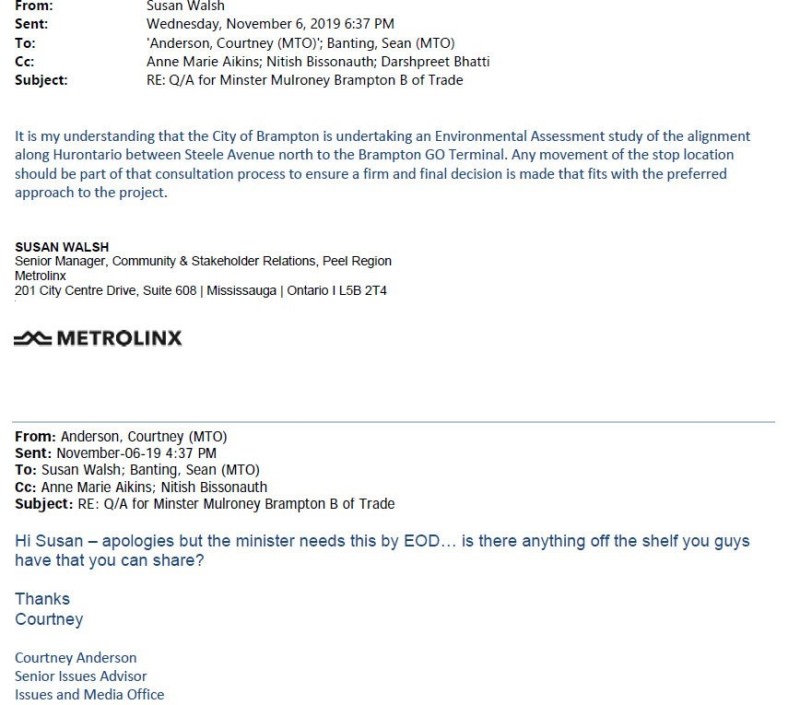
Despite refusals from Ministry and Metrolinx officials, Brampton staff and elected officials continued to push for the north side stop. On March 6, 2020, Brampton’s Chief Administrative Officer, David Barrick wrote to Shelley Tapp, the Deputy Minister of Transportation and Metrolinx’s Phil Verster noting that the city requested Metrolinx to have Mobilinx “determine the design, cost and timing of moving the Gateway LRT Stop from the south side of Steeles Avenue, as currently planned, to the north side of the Hurontario Street and Steeles Avenue intersection. We are waiting for the authority to proceed with an agreement for the design cost to undertake this work, with is presently with MTO staff.”
Barrick confirms that “the City of Brampton will pay for the reasonable design costs for the relocation of the Hurontario LRT Stop…. Once the cost and scope of this work has been determined, City of Brampton staff will work quickly to have this presented to Brampton City Council for review and approval.”

In response to Barrick’s letter, staff at MTO noted that in early January 2020, RioCan wrote to the ministry asking that the stop be relocated north of Steeles Avenue. In response to RioCan’s request, MTO wrote that the project already achieved financial close. They went on to state that “under the current project agreement, the stop is on the south side of Steeles Avenue. Moving the stop at this point would be priced as a variance to the project without the pressure of competitive bidding. The change would also impact the construction process, schedule and future LRT operations.”
The official response from Phil Verster was sent back to Barrick on April 14, 2020, followed by the response from MTO’s Shelley Tapp on April 15, 2020.
Interestingly, Verster’s response states that “there are no appreciable differences in customer benefits as a result of placing the Gateway stop to the north side of Steeles Avenue” Furthermore, he says that “a thorough safety analysis completed in 2018 concluded that there were no significant differences in pedestrian and vehicular safety at the Steeles Avenue and Hurontario Road intersection with and without LRT.” (This does not specifically state whether there were any significant differences according to the stop location.)
Perhaps most importantly, the costs of relocating the stop post-financial close are laid out for the first time. Verster also warned about the precedent such a change would make:
“Changing the stop location to the north side of Steeles Avenue, in a live contract, is anticipated to cost approximately $15-20M together with an impact to the project completion date without a clear need and justification. Of great concern is the potential precedence this will establish for many other requests for changes to the project scope with major cost and schedule impacts.”
Had Brampton gotten its wish for altering the contract, it is possible that Mississauga would demand changes as well, such as the restoration of the loop through the city centre, and even a new stop demanded by some residents at Knightsbridge Circle.
Both Verster and Tapp noted the opportunities for a future extension northward, and now the south side stop “preserves maximum flexibility for future LRT extensions to the north.”
Despite these rejections by senior Metrolinx and MTO officials, Brampton continued to push for the north side stop.
On April 21, 2020, Brampton Mayor Patrick Brown wrote to Caroline Mulroney, the Minister of Transportation. In that letter, Mayor Brown acknowledges receipt of the letter from the deputy minister. Brown notes that Brampton is prepared to cover the design costs to relocate the LRT stop, and that the city is not “looking to add a new stop but, are requesting to relocate the planned stop 50 metres north.”
Brown notes that the new location better facilitates the existing Brampton Gateway Terminal.

The response from Minister Mulroney was sympathetic, but firm in backing Metrolinx’s position. Provincial funding for moving the stop would not be made available and that “given the scale of this project and the commitment to ensure milestones are met, the province and Metrolinx will be continuing work on the project as currently planned.”
On June 3, 2020, Brampton’s Committee of Council voted to continue proceeding with design work for the Main Street LRT extension to Downtown Brampton. At that point, staff reduced the alternatives to two — a direct surface route to the Brampton GO Station, eliminating a potential one-way loop in the downtown core, or a bored tunnel from Nanwood Drive north, under Etobicoke Creek.
Brampton CAO Barrick writes again to Phil Verster on July 20, 2020, while Mayor Brown writes to Minister Mulroney on July 30, 2020. Both letters inform the respective officials of the Committee of Council vote to continue work on the Main Street extension
Barrick’s letter to Verster notes the challenges to making any change to the project scope, but argues that “there continues to be distinct benefits in relocating the LRT Brampton Gateway Stop north of Steeles Avenue, namely being its proximity to the existing transit terminal for safe and convenient passenger transfers, and it’s potential compatibility with the future LRT north extension along Main Street.”
Brown uses similar language in his letter to Mulroney, below, while also looking for further dicussion on “the risks, costs and benefits including
potential impacts, and any throwaway costs associated with keeping the stop to south of Steeles Avenue and deferring the relocation of the stop to the north of Steeles Avenue as part of the HuLRT implementation.”
There is little to note in Minister Mulroney’s response in an undated letter to Mayor Brown, apart from an acknowledgement that “the benefit-cost ratio between the two options (north side of Steeles Avenue and south side of Steeles Avenue) remains the same” but that “changing the stop location at this stage will lead to additional costs and delays.”
The last communication received in my package from Metrolinx is another letter from Mayor Brown to Minister Mulroney, dated January 26, 2021. Brown notes that the city “has funded further development on the costs and impacts associated with the relocation of the final stop approximately 75 metres north of where it is currently planned (i.e., to the north side of Steeles Avenue).” Brown goes on to say that the “City has engaged with a developer [RioCan] to transform the northwest corner of Steeles and Hurontario [Shoppers World] into several hundred multi-residential units. As a result, re-locating the LRT stop to the north side of Steeles would not only serve to create a single transit hub with connections to 2 Züm BRT lines, but would also accomplish the Province’s goal of locating transit directly adjacent to where people live.”
Analysis and conclusions

Unfortunately, that 6-5 vote against the northern section of the Hurontario-Main LRT in October 2015 and the subsequent vote on February 15, 2017 to request Metrolinx move the Brampton Gateway LRT stop to the south side of Steeles Avenue created the problem that a newer, more progressive city council is unable to solve in the short-to-medium term.
By the time the new council was elected, in late 2018, a new provincial government, focused on reducing spending on operating expenses and capital projects, was in charge. Meanwhile Metrolinx was finalizing the procurement of the shortened Hurontario LRT project, reduced even further by government decree in March 2019.
Though moving the Brampton Gateway stop back to a safer and more convenient location, as requested by the City and by a major developer, would not have been especially difficult or expensive (especially given Brampton’s willingness to fund the design costs), it would have meant making an alteration that Metrolinx and the Ministry of Transportation were unwilling to make. Though Metrolinx’s mandate is to integrate and coordinate transit across the GTHA, the south side stop will only serve as a barrier between LRT and bus.
Spending a little more time and money to move the Brampton Gateway stop back to a safer and more convenient location, especially when the City of Brampton was willing to fund the additional design costs and expedite approvals, would have ensured that the project was done right.
It is also worth noting that while it appears that little effort is made to mitigate the problematic transfer at Brampton Gateway, with the province determined to keep costs down and the project on track, other transit projects have received much more attention and funding from the province.
The planned Eglinton West LRT extension between Mount Dennis and Renforth Gateway terminal will be fully tunneled, adding $1.8 billion to that project’s cost despite previous proposals for a cheaper surface route in the median of Eglinton Avenue. The province is also moving ahead with the Ontario Line, the Scarborough Subway Extension, and the Yonge Subway Extension to Richmond Hill, all multi-billion-dollar contracts.
Therefore, it is puzzling to see why the province is so determined not to move one LRT terminal stop 75 metres to the north for the safety and comfort of thousands of passengers. This appears to be largely a class issue, where organized and affluent residents and property owners’ desires trump the needs of thousands of daily transit riders? The decisions made by a slim majority of Brampton Council between 2015 and 2018 certainly point to this, perhaps without realizing the safety issues made as a result of their opposition to a direct Main Street route to Downtown. Sitting councillors Jeff Bowman (who represents Wards 3 & 4, where the Brampton Gateway Terminal is located), Doug Whillians, and Michael Palleschi voted in opposition to the LRT in 2015 and supported studying lengthy alternative routes instead.
The communications received from Metrolinx also leave it unclear how much pressure government MPPs Prabmeet Sarkaria (currently President of the Treasury Board, a powerful cabinet position) and Amarjot Sandhu have been putting on the Minister of Transportation and Metrolinx.
To his credit, Mayor Patrick Brown has been able to work with council and has pushed for the safety and comfort of transit riders at Brampton Gateway Terminal since his election.
To date, no revised drawing for the Steeles-Hurontario intersection with the south side stop has been made public; the roll drawings on Metrolinx’s website still show a planned tunnel that has since been determined “out of scope.” There are measures that can be made to mitigate crowding and pedestrian safety concerns with a south-side stop (for example, a mid-intersection crosswalk across Steeles Avenue), but nothing has been indicated so far.
Unfortunately, while the City of Brampton understands the issues of pedestrian safety and the comfort of those thousands of daily commuters using the LRT, it appears that the provincial government and Metrolinx do not. This might explain some of the stubbornness on their behalf.
I expect that there will be more to this story, and I will continue to update readers on the future Brampton Gateway stop location.


